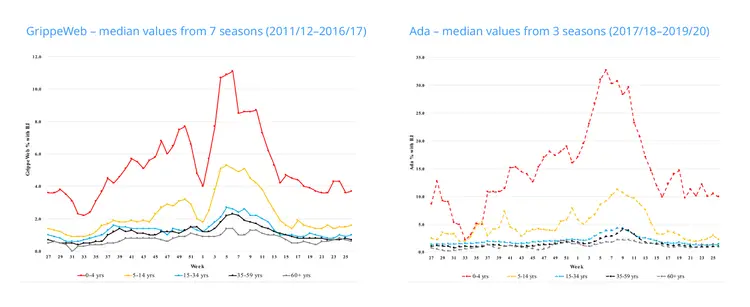For many of us, a bout of flu should pass without too many complications. Usually, a week of rest and recuperation will have us back fighting fit. But for people living with existing conditions or a weakened immune system, flu can be deadly.
Worldwide, flu causes an estimated 3 to 5 million cases of severe illness and about 290,000 to 650,000 die from the flu each year. 1 The impact of flu is even higher in developing countries.
Public health bodies and care providers can limit the suffering and economic burden caused by flu with careful public health planning including the use of flu vaccines to contain its spread.
But one of the greatest challenges in the fight against flu is identifying outbreaks before they go out of control.
With our rich health datasets, we were curious to find out if we could support efforts to monitor the global flu situation. We even published our results in a peer-reviewed study.
But before we get to that, let’s start with a little background.
How are flu outbreaks tracked today?
The World Health Organization recommends syndromic surveillance of influenza-like-illness (ILI) to monitor outbreaks and trends and to determine when flu season is. 2
In simple terms, that means monitoring the symptoms people report to their doctors to identify disease hotspots and track outbreaks.
When ILI symptoms start to emerge in a population, public health officials and health system leaders can trigger prevention strategies to curb the spread of flu and provide appropriate support, treatment, or services.
Many European countries collect ILI syndromic surveillance data using internet-based reporting tools run by public health institutes. One example is Germany’s GrippeWeb from the Robert Koch Institute. 3
These syndromic surveillance systems are powerful tools in the fight against influenza. But they have some limitations.
Syndromic surveillance: what’s the catch?
Many syndromic surveillance tools have a time lag before data becomes available for analysis. 4
Timing is crucial in containing the spread of a condition like flu; the shape of an epidemic curve could be pivotal in guiding the rollout of appropriate health measures.
Filling the gap between symptom reporting and data analysis is where Ada data could transform syndromic surveillance.
Now, let’s get to our published research.
Could Ada data help speed up influenza responses?
Every day, Ada helps millions of people from around the world understand their symptoms for flu alongside thousands of other conditions. Many of those people consent to sharing anonymous information about their symptoms to support research initiatives like this one.
This data could help make real-time ILI symptom monitoring possible, as Ada assessment data is immediately available for interpretation.
But to inform public health decision-making, that data needs to paint a highly accurate picture of the regional influenza situation.
So we set out to investigate how closely Ada data matches the ILI trends shown by syndromic surveillance tools.
How does Ada data match up to current syndromic surveillance tools?
We analyzed 2.1 million Ada assessments completed in Germany across 3 flu seasons between 2017 and 2020. 5 We only included data provided by users who had consented to anonymous analysis for public health purposes.

We compared the ILI symptom trends in Ada data to the trusted user-reported data on GrippeWeb for the same flu seasons.
To do this, we used scatterplots and explored correlations using the Pearson correlation coefficient, with values for r, 95% CI, and P values at the significance level of .05.
The Ada and GrippeWeb data showed significant correlation across the flu seasons we analyzed (P<.001 in all 3 seasons.)

Graph showing the ILI rates as identified by GrippeWeb and Ada across 3 flu seasons.
When we stratified the data by age groups, the Ada and GrippeWeb data also showed significant correlation ( P<.001 in all cases.)

Graph showing the age-stratified ILI estimates as identified by GrippeWeb and Ada across 3 flu seasons.
Ada as a real-time syndromic surveillance tool
Our research showed that real-time analysis of Ada data replicated the trends seen in GrippeWeb across 3 flu seasons. When we stratified by age, Ada data predicted ILI rates that showed a high similarity to those of GrippeWeb, including for ages that sat outside the average Ada user range.
These results show that, by taking advantage of Ada’s rapid data availability, health bodies and care providers could add value to syndromic surveillance systems with earlier insights.
By speeding up the syndromic surveillance process, these data insights could allow for faster action to reduce morbidity and mortality of illnesses like influenza.
Ada data could be particularly valuable in countries that do not have existing population-based monitoring systems, although further analysis would be necessary to confirm this.
If you’d like to learn more about data at Ada or are interested in partnering with us, get in touch.
- https://www.who.int/news-room/fact-sheets/detail/influenza-(seasonal)
- http://www.euro.who.int/en/health-topics/communicable-diseases/influenza/seasonal-influenza/surveillance-and-lab-network/influenza-surveillance-country-profiles
- https://grippeweb.rki.de/
- https://www.nature.com/articles/s41598-017-01259-5
- JMIR Public Health Surveill 2021;7(11):e26523, https://publichealth.jmir.org/2021/11/e26523 DOI: 10.2196/26523

